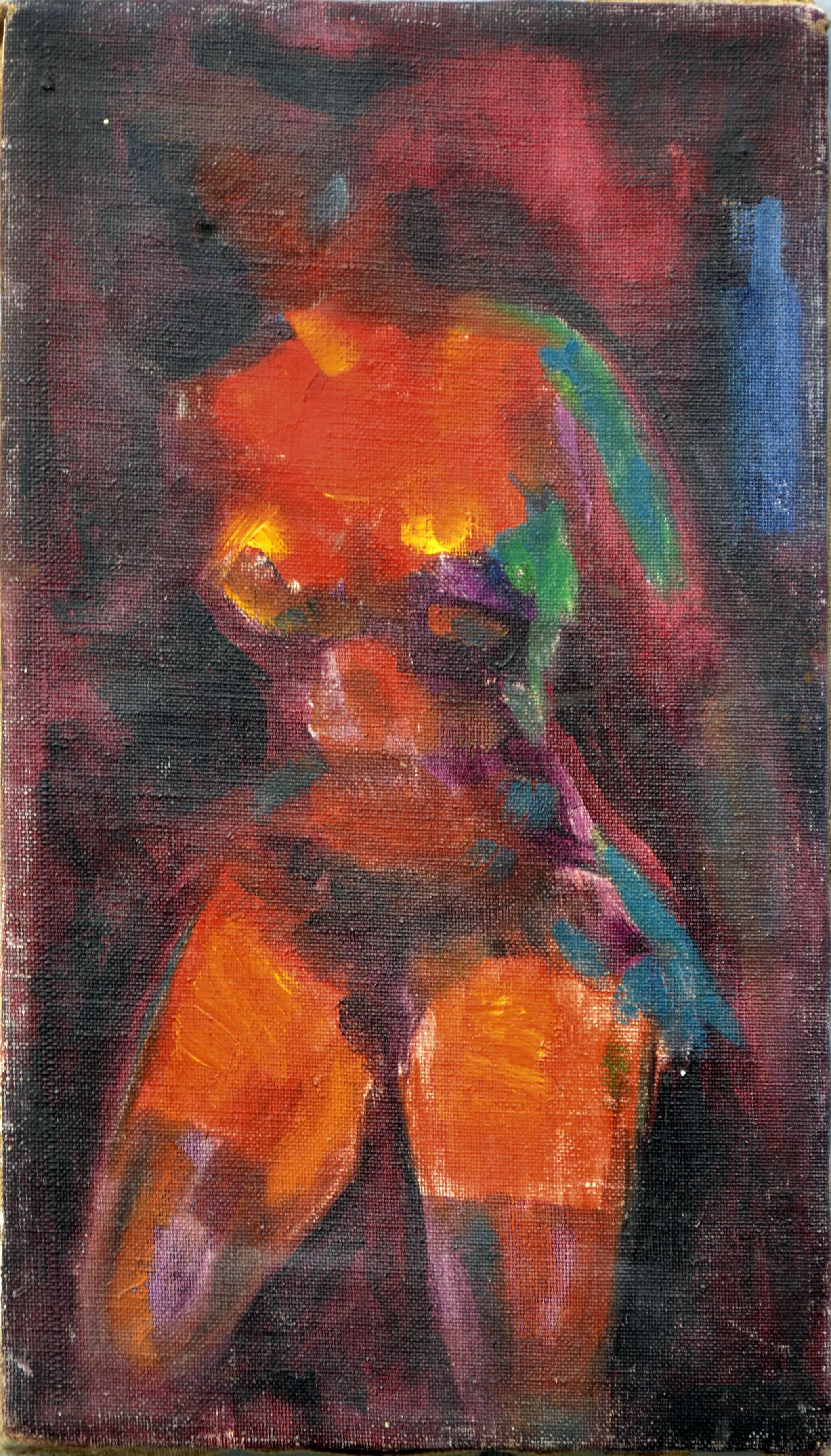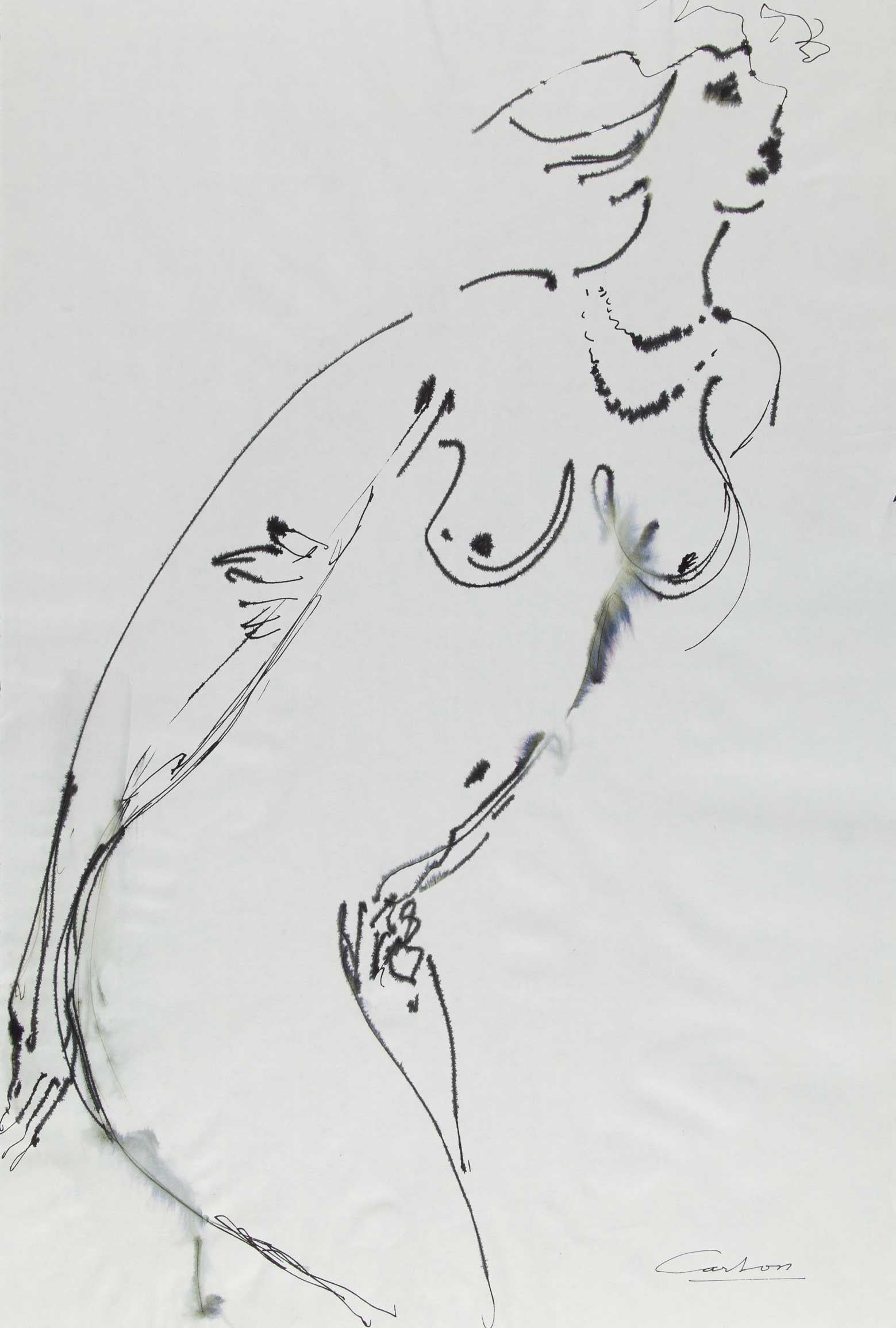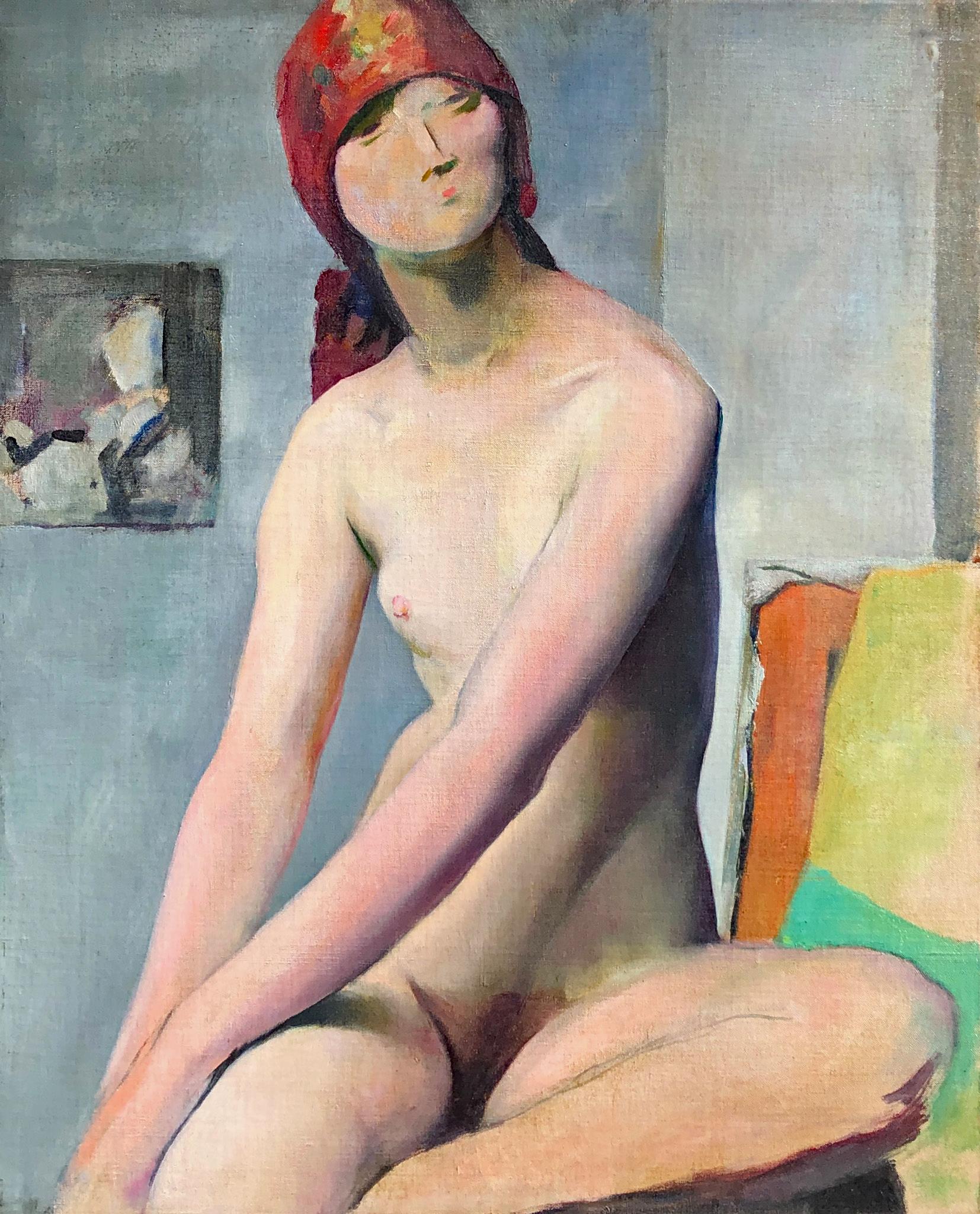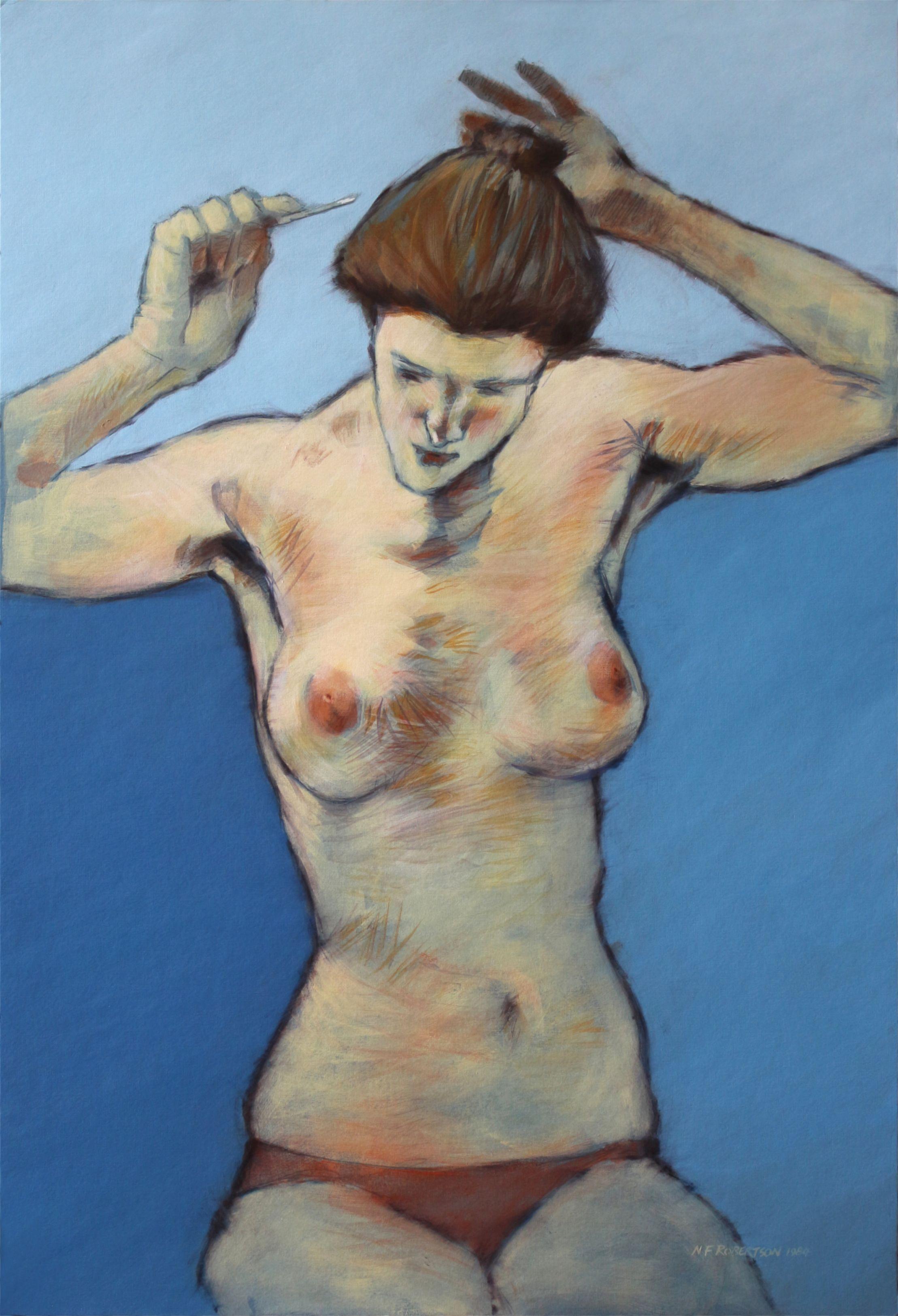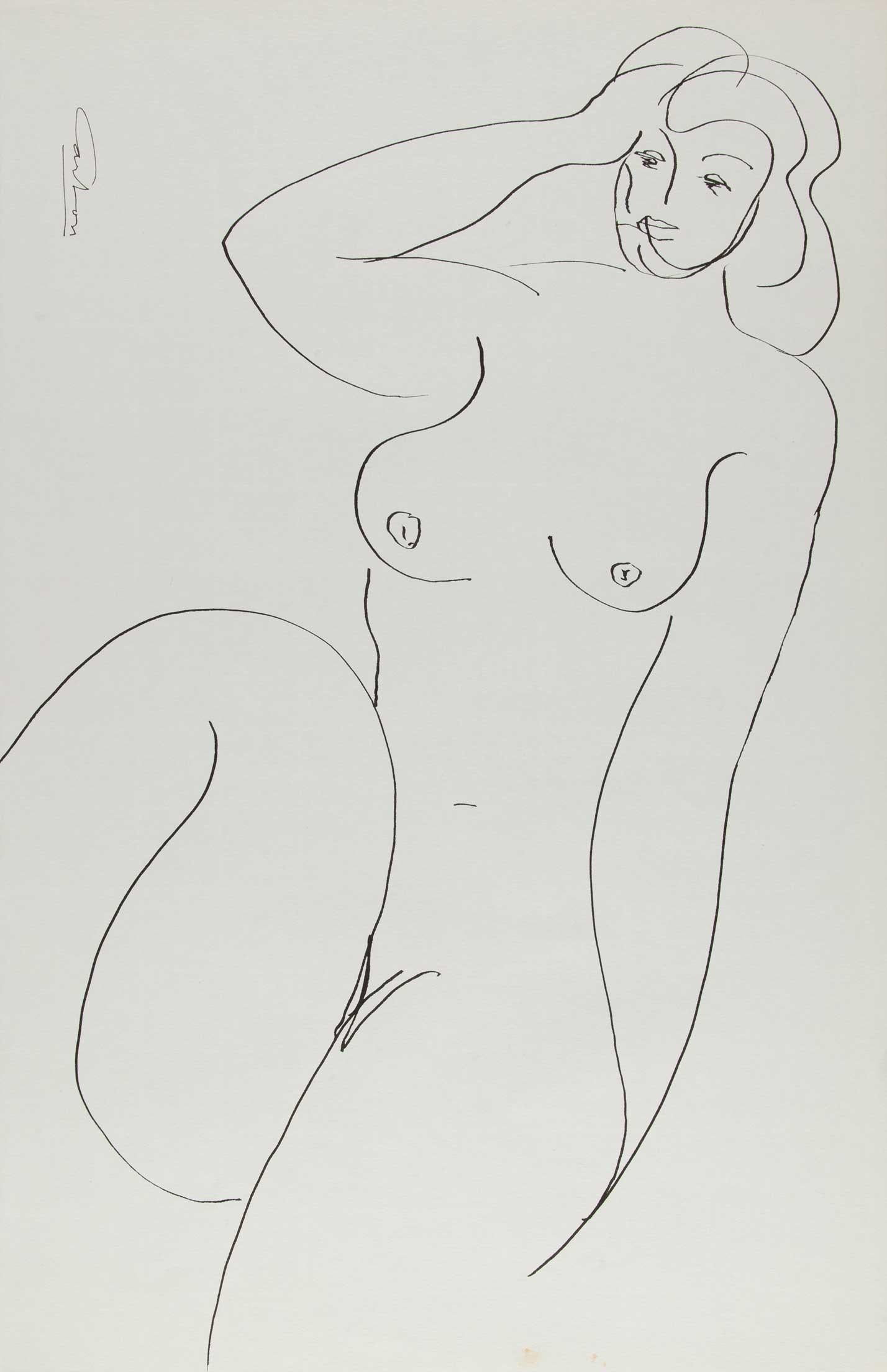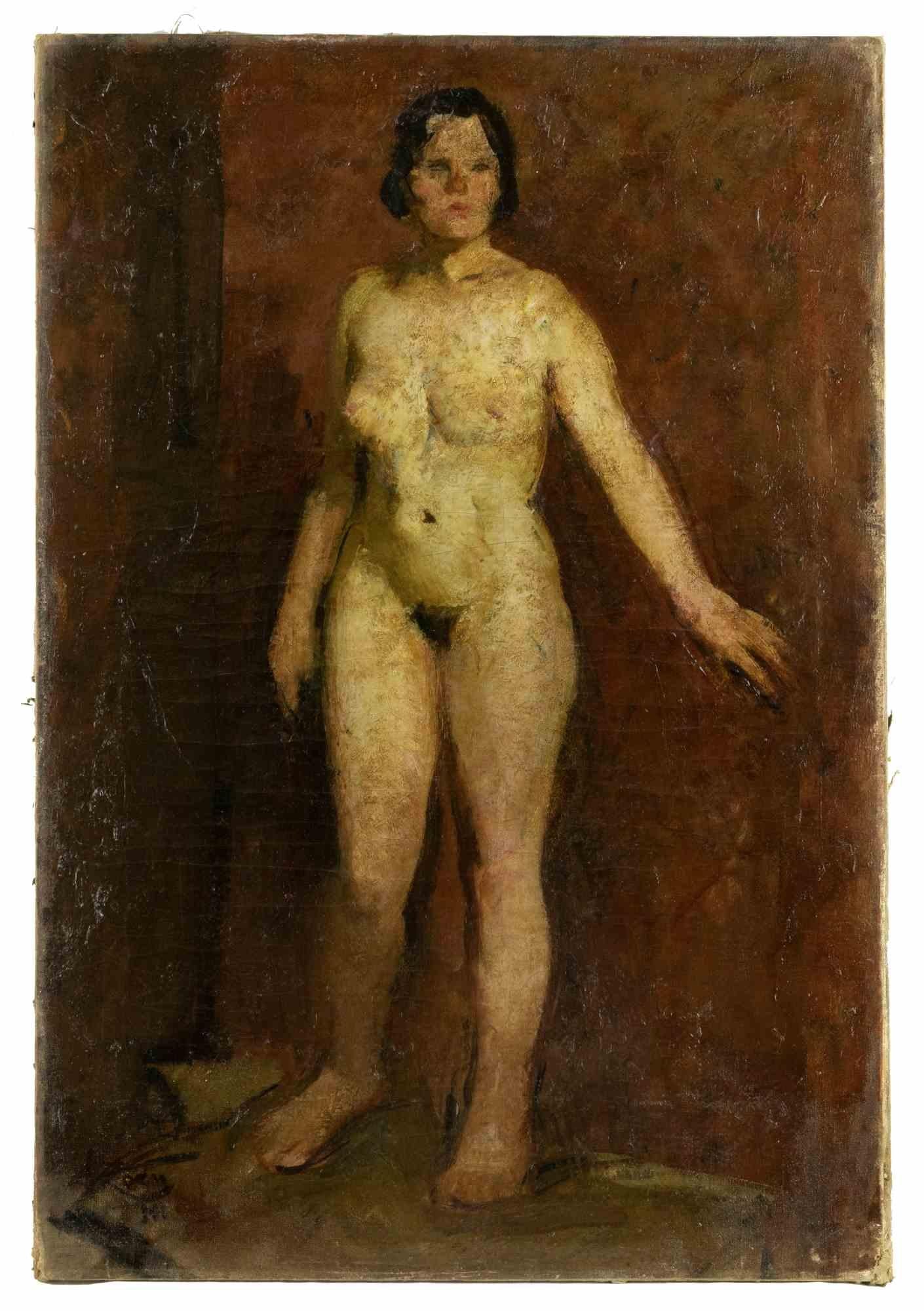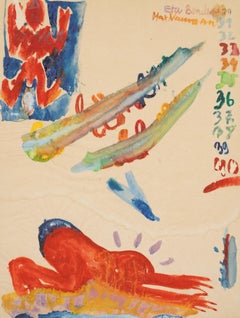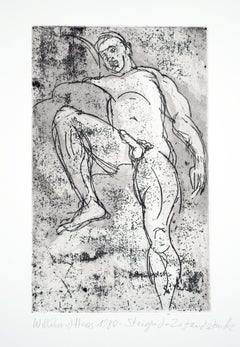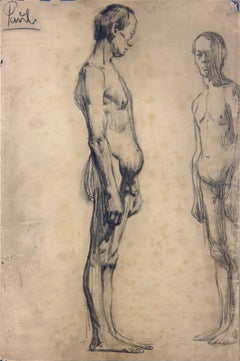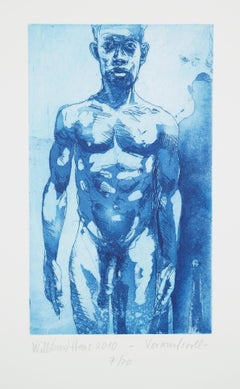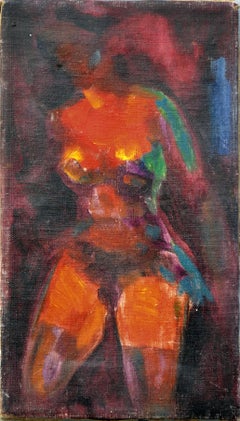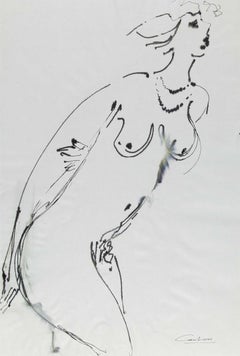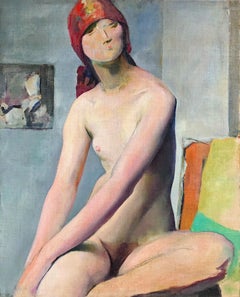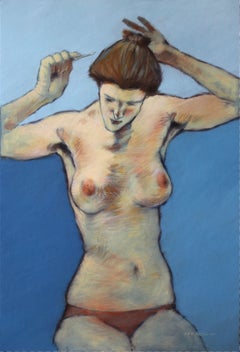Items Similar to Small Nude / - Abstract Figurativity -
Want more images or videos?
Request additional images or videos from the seller
1 of 10
Gustl StarkSmall Nude / - Abstract Figurativity -1946
1946
$2,664.08
$3,330.1020% Off
£1,994.68
£2,493.3520% Off
€2,240
€2,80020% Off
CA$3,725.96
CA$4,657.4520% Off
A$4,060.96
A$5,076.2020% Off
CHF 2,114.76
CHF 2,643.4620% Off
MX$48,998.48
MX$61,248.1020% Off
NOK 26,583.45
NOK 33,229.3120% Off
SEK 24,955.67
SEK 31,194.5920% Off
DKK 17,064.56
DKK 21,330.6920% Off
About the Item
Gustl Stark (1917 Mainz - 2009 ibid.), Small Nude, 1946. Oil on canvas, marouflaged, 54 x 25 cm (picture), 30 x 60 cm (frame), signed "Stark" top left, verso twice signed "Gustav Stark", inscribed by hand as "Small Nude" and dated by hand "1946". With label of the exhibition of the Bundeshaus Bonn from 1956.
- Rubbed area in the lower third of the body, at the same level a retouch in the ochre background. I provisional frame.
- Abstract Figurativity -
About the artwork
During the war, Gustl Stark suffered a particularly severe blow for an artist: he lost his right arm. Nevertheless, he continued to devote himself to art, and the painting, created in 1946, immediately after the end of the Nazi reign of terror, testifies to the dawn of a new era. At the same time, the work is a rare example of the artist's early figurative work, as Stark turned entirely to abstract painting as early as 1950. And even this painting is by no means purely figurative; rather, it already illustrates Stark's turn toward abstraction.
We see a female nude, but one that remains faceless. This can be read symbolically and in relation to the immediate past epoch, which, in the face of horrors, silences and blinds - literally renders faceless. In this sense, the figure is positioned to 'look back'. But she does not look. While this meaning may resonate and make the painting an important work of the immediate postwar period, Gustl Stark is primarily concerned with something else here, namely art itself. The absence of the face leads to the body becoming something flat. Due to the de-individualization, we do not see a concrete person with his individual features, but a body surface. And indeed, the body is constructed through an extremely planar design. Even the contour lines that form the corporeality have a planar rather than a linear character, especially where they merge into shadow zones of almost the same color. And the surfaces themselves are not modeled. The incarnate parts do not show any plastic gradations; the corporeality is completely withdrawn into the plane, which is also true for the hair. In addition, there is no uniform background against which the figure could appear; rather, the area next to the hair is kept bluish, creating a succession of earth-toned colored areas, which again binds the figure to the surface.
Last but not least, the flatness is also forced by the painting technique. Gustl Stark paints directly, a la prima, onto the coarse canvas, whereby the structure of the painting support remains visible in the picture, and in places - around the hair, for example - the canvas itself can be seen. This structural all-over lends the picture a certain flatness.
Gustl Stark thus uses the very motif that stands for the corporeality of art par excellence - the female nude - to transform the spatiality of the traditional picture into a flatness characteristic of modern art. And yet, a strong impression of corporeality is created, without being produced by a painterly modeling of the body. The oscillation between flatness and corporeality creates the intense tension of this groundbreaking painting.
In Gustl Stark's oeuvre, as a consequence of the abstraction we see here, the figurative is completely stripped away in a further step, which is also a loss when looking at this early key work.
About the artist
Gustl Stark was the son of a woodcarver and, after an apprenticeship as a decorative painter, attended the State School of Arts and Crafts in Mainz from 1936 to 1937. Although he was severely wounded in the war and lost his right arm, he studied at the Würzburg School of Painting and Drawing from 1943-1944 and then at the Academy of Fine Arts in Nuremberg from 1944-1948.
He won a state scholarship at the state art competition in Bad Ischl. Numerous study trips to Sylt, Paris, Switzerland, Austria, Italy, Holland and Belgium followed.
Gustl Stark worked in Mainz and was the first artist there to focus on abstract painting. His work quickly gained international recognition, including the Salon Réaliés Nouvelles in Paris.
From 1963-1970 he taught at the State University Institute for Art and Work Education in Mainz and from 1970-1975 at the Johannes Gutenberg University. Gustl Stark became particularly famous for his color embossed prints, for which he invented his own technique.
Gustl Stark received numerous awards for his work. He received the Art Prize for Painting of the City of Mainz in 1962, the State Prize of Rhineland-Palatinate in 1984, and the Gutenberg Bust of the City of Mainz in 1987.
Selected Bibliography
Hans Vollmer (Hrsg.): Allgemeines Lexikon der bildenden Künstler des XX. Jahrhunderts, Vierter Band, Leipzig 1958, S. 344.
Hans H. Hofstätter: Das malerische Werk Gustl Starks (= Kleine Schriften der Gesellschaft für bildende Kunst Mainz), Mainz 1962.
Wolfgang Venzmer: Zu Gustl Starks Prägetiefdrucken, Mainz 1982.
Gustl Stark: Prägetiefdrucke. Werkverzeichnis 1966-1990, Mainz 2003.
GERMAN VERSION
Gustl Stark (1917 Mainz - 2009 ebd.), Kleiner Akt, 1946. Öl auf Leinwand, maroufliert, 54 x 25 cm (Darstellung), 30 x 60 cm (Rahmen), oben links mit „Stark“, verso zweifach mit „Gustav Stark“ signiert, als „Kleiner Akt“ handbezeichnet und auf „1946“ handdatiert. Mit Aufkleber der Ausstellung des Bonner Bundeshauses aus dem Jahre 1956.
- beriebene Stelle im unteren Drittel des Körpers, auf derselben Höhe eine Retusche im ockerfarbenen Hintergrund. Im provisorischen Rahmen.
Exposé als PDF
- abstrakte Figürlichkeit -
zum Kunstwerk
Im Krieg erlitt Gustl Stark einen Schicksalsschlag, der für einen Künstler besonders schwerwiegend ist: Er verlor seinen rechten Arm. Dennoch widmete er sich auch weiterhin ganz und gar der Kunst und das 1946, unmittelbar nach dem Ende der nationalsozialistischen Schreckensherrschaft geschaffene Gemälde zeugt vom Aufbruch in eine neue Zeit. Zugleich ist das Werk ein rares Beispiel für das frühe figürliche Oeuvre des Künstlers, da sich Stark bereits ab 1950 ganz der abstrakten Malerei zuwandte. Und auch dieses Bild ist keineswegs rein figürlich, vielmehr veranschaulicht es bereits Starks Hinwendung zur Abstraktion.
Wir sehen einen weiblichen Akt, der jedoch gesichtslos bleibt. Dies mag symbolisch gelesen und auf die unmittelbar vergangene Epoche bezogen werden, die angesichts der Schrecken verstummen und erblinden lässt – förmlich gesichtslos macht. In diesem Sinne ist die Figur so positioniert, dass sie ‚zurückblickt‘. Aber sie blickt eben nicht. Mag dieser Bedeutungsgehalt auch mitschwingen, wodurch das Gemälde zu einem wichtigen Werk der unmittelbaren Nachkriegszeit wird, geht es Gustl Stark hier doch primär um etwas anderes, nämlich um die Kunst selbst. Das Fehlen des Gesichts führt dazu, dass der Körper zu etwas Flächenmäßigem wird. Aufgrund der Ent-Individualisierung sehen wir keine konkrete Person in ihren individuellen Zügen, sondern eine Körperfläche. Und tatsächlich ist der Körper durch eine äußerst flächenmäßige Gestaltung aufgebaut. Selbst die Konturlinien, die die Körperlichkeit formieren, weisen einen eher flächenmäßigen als linearen Charakter auf, insbesondere dort, wo sie in beinahe gleichfarbige Schattenzonen übergehen. Und die Flächen sind nicht in sich modelliert. Das Inkarnat weist keinerlei plastische Abstufungen auf; die Körperlichkeit ist ganz ins Flächenmäßige zurückgenommen, was in demselben Maße auch für die Haare gilt. Zudem gibt es keinen einheitlichen Hintergrund, der die Figur vor sich erscheinen lassen würde, vielmehr ist der Bereich neben den Haaren bläulich gehalten, so dass eine Abfolge an erdtonalen Farbflächen entsteht, wodurch die Figur abermals in die Fläche zurückgebunden ist.
Nicht zuletzt wird die Flächenmäßigkeit auch durch die Maltechnik forciert. Gustl Stark malt direkt, a la prima, auf die grobe Leinwand, wodurch die Struktur des Bildträgers im Bild sichtbar bleibt und stellenweise – etwa um die Haare herum – die Leinwand selbst zu sehen ist. Dieses strukturelle all-over verleiht dem Bild per se etwas Flächenmäßiges.
Gustl Stark bedient sich mithin gerade jenes Motivs, das für die Körperlichkeit der Kunst schlechthin einsteht – dem weiblichen Akt –, um die Räumlichkeit des traditionellen Bildes in eine für die moderne Kunst charakteristische Flächenmäßigkeit zu überführen. Und dennoch wird ein starker Eindruck von Körperlichkeit erzeugt, ohne dass diese jedoch durch eine malerische Modellierung des Körpers erzeugt worden wäre. Aus dem Oszillieren zwischen Flächigkeit und Körperlichkeit resultiert die intensive Spannung des wegweisenden Bildes.
Innerhalb von Gustl Starks Oeuvre liegt es in der Konsequenz der hier vor Augen stehenden Abstraktion in einem weiteren Schritt die Figürlichkeit gänzlich absteifen, was – auf dieses frühe Schlüsselwerk geschaut – aber auch einen Verlust bedeutet.
zum Künstler
Gustl Stark war der Sohn eines Holzschnitzers und besuchte nach einer Lehre als Dekorationsmaler von 1936-1937 die Staatsschule für Kunst und Handwerk in Mainz. Obwohl er im Krieg schwer verwundet worden war und seinen rechten Arm verloren hatte, studierte er von 1943-1944 an der Mal- und Zeichenschule Würzburg und anschließend, von 1944-1948, an der Akademie der bildenden Künste in Nürnberg.
Beim staatlich ausgelobten Kunstwettbewerb in Bad Ischl gewann er ein Staatsstipendium. Es folgten zahlreiche Studienreisen nach Sylt, Paris, in die Schweiz, nach Österreich, Italien Holland und Belgien.
Gustl Stark war in Mainz tätig und dort der erste Künstler, der sich der abstrakten Malerei widmete. Schnell fand sein Werk auch internationale Anerkennung, so beschickte er unter anderem den Salon Réaliés Nouvelles in Paris.
Von 1963-1970 lehrte er am Staatlichen Hochschulinstitut für Kunst- und Werkerziehung in Mainz und hatte von 1970-1975 einen Lehrauftrag an der Johannes-Gutenberg-Universität inne. Eine besondere Bekanntheit erlangte Gustl Stark durche seinen farbigen Prägedruck, für den er eine eigene Technik erfunden hatte.
Für sein Schaffen wurde Gustl Stark mit zahlreichen Auszeichnungen geehrt. Unter anderem erhielt er 1962 den Kunstpreis für Malerei der Stadt Mainz, 1984 den Staatspreis des Landes Rheinland-Pfalz und 1987 die Gutenberg-Büste der Stadt Mainz.
Auswahlbibliographie
Hans Vollmer (Hrsg.): Allgemeines Lexikon der bildenden Künstler des XX. Jahrhunderts, Vierter Band, Leipzig 1958, S. 344.
Hans H. Hofstätter: Das malerische Werk Gustl Starks (= Kleine Schriften der Gesellschaft für bildende Kunst Mainz), Mainz 1962.
Wolfgang Venzmer: Zu Gustl Starks Prägetiefdrucken, Mainz 1982.
Gustl Stark: Prägetiefdrucke. Werkverzeichnis 1966-1990, Mainz 2003.
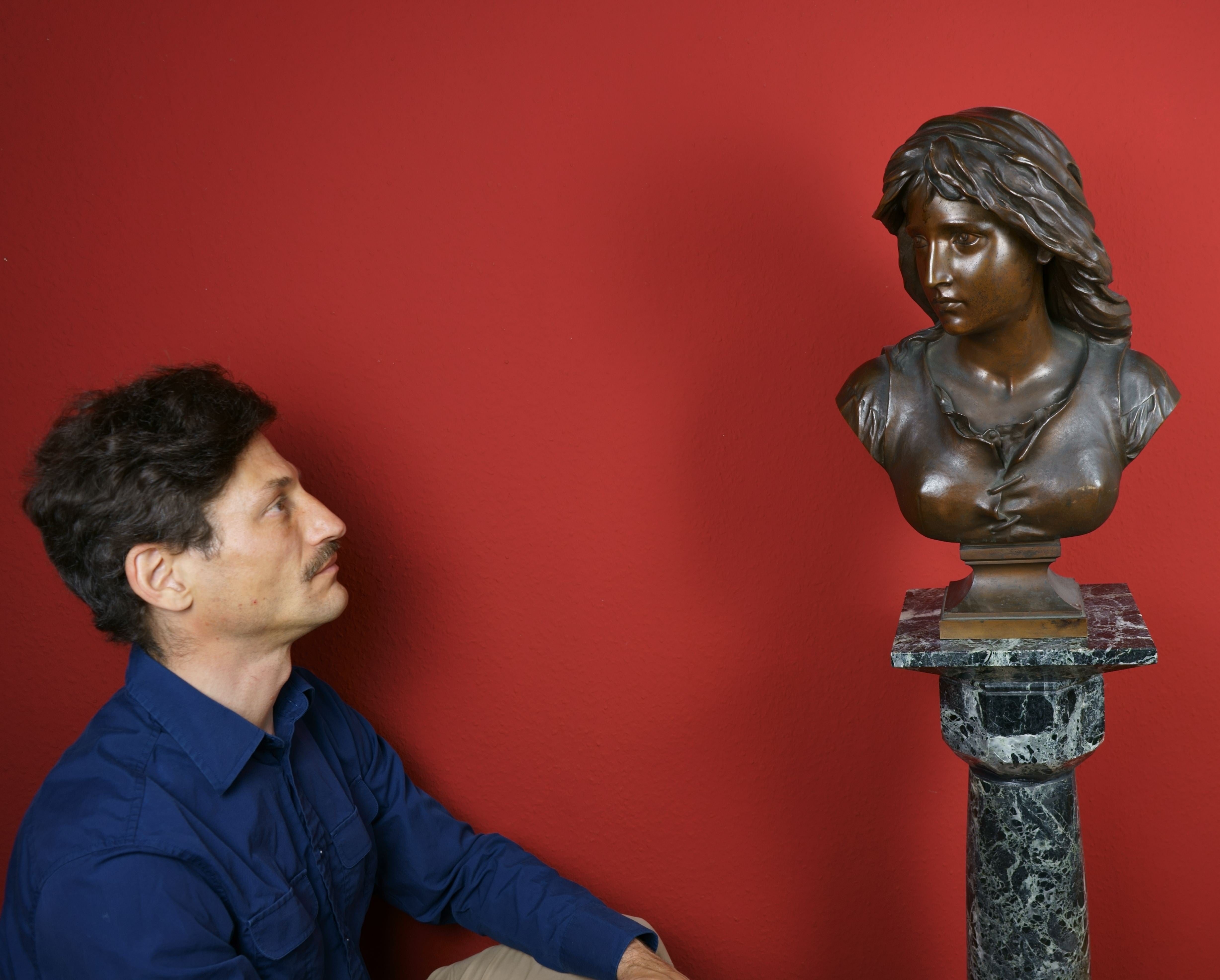
About the Seller
5.0
Vetted Professional Seller
Every seller passes strict standards for authenticity and reliability
Established in 2014
1stDibs seller since 2023
22 sales on 1stDibs
- ShippingRetrieving quote...Shipping from: Berlin, Germany
- Return Policy
Authenticity Guarantee
In the unlikely event there’s an issue with an item’s authenticity, contact us within 1 year for a full refund. DetailsMoney-Back Guarantee
If your item is not as described, is damaged in transit, or does not arrive, contact us within 7 days for a full refund. Details24-Hour Cancellation
You have a 24-hour grace period in which to reconsider your purchase, with no questions asked.Vetted Professional Sellers
Our world-class sellers must adhere to strict standards for service and quality, maintaining the integrity of our listings.Price-Match Guarantee
If you find that a seller listed the same item for a lower price elsewhere, we’ll match it.Trusted Global Delivery
Our best-in-class carrier network provides specialized shipping options worldwide, including custom delivery.More From This Seller
View AllFigurative Composition / - Expressive Signs -
Located in Berlin, DE
Max Neumann (* 1949 Saarbrücken) and Eta Bender (*1948 Heidelberg), Figurative Composition, around 1970. Mixed media on tracing paper, mounted on thin backing paper, 29.6 cm x 21 cm,...
Category
1970s Abstract Expressionist Figurative Drawings and Watercolors
Materials
Paper
Rising
Located in Berlin, DE
Willibrord Haas (*1936 Schramberg), Rising, 1980. Etching, 35 cm x 22 cm (plate size), 53.5 cm x 38 cm (sheet size). Signed “Willibrord Haas” in pencil by the artist, dated “1980”, t...
Category
1980s Realist Nude Prints
Materials
Paper
Self-portrait - Homo nudus -
Located in Berlin, DE
Bruno Paul (1874 Seifhennersdorf - 1968 Berlin). Self-portrait, c. 1895. Pencil on paper, mounted on cardboard, 53.5 x 35 cm, signed 'Paul' at upper left.
- Homo nudus -
About the artwork
In a mirrored situation, Bruno Paul looks at himself in the picture. While his body, which is the size of the format, is shown in profile parallel to the picture, he turns his head into the picture in order to become aware of himself there, whereby the lighter use...
Category
1890s Realist Figurative Drawings and Watercolors
Materials
Pencil
$3,320 Sale Price
20% Off
Reproachful
Located in Berlin, DE
Willibrord Haas (*1936 Schramberg), Reproachful, 2010. etching, 33.5 cm x 20 cm (plate size), 54 cm x 37.5 cm (sheet size). Signed “Willibrord Haas” in lead by the artist, dated “201...
Category
2010s Realist Nude Prints
Materials
Paper
Untitled / - Association -
Located in Berlin, DE
Detlef Baltrock (*1954 Stuttgart), Untitled, 1985. Watercolor, 29.5 cm x 21 cm (visible dimensions), 41 cm x 32 cm (frame), signed “Baltrock” lower center and signed “[19]85”, label ...
Category
1980s Abstract Expressionist Abstract Drawings and Watercolors
Materials
Paper
The Hunchback / - Strange beauty -
By Reiner Schwarz
Located in Berlin, DE
Reiner Schwarz (*1940 Hirschberg), The Hunchback, 1969. Lithograph, 33 cm x 22 (depiction), 59 cm x 42 cm (sheet size), signed “R.[einer] Schwarz” in pencil lower right, dated “[19]6...
Category
1960s Surrealist Figurative Prints
Materials
Paper
You May Also Like
Abstract Expressionist Multicolor Nude Figure
By Tom Hamil
Located in Soquel, CA
Vivid abstract expressionist painting of a colorful nude female figure by the artist Tom Hamil (American, b. 1928). Signed on verso "Tom Hamil". Circa 1970's. Unframed. Image size: 14"H x 8"W.
Tom Hamil, was born in New York in 1928 and raised primarily in California. After attending the US Naval Academy in Annapolis, he returned to California to begin his formal art training at the California School of Fine Arts in San Francisco (now known as the San Francisco Art Institute). He completed his education at the University of Washington with a Master’s Degrees and Doctorate in Fine Arts and Education. His first solo exhibition was held in 1956. Since then, he has participated in numerous one man shows, group shows, and has been represented in galleries in the US and Mexico.
In addition to his painting, Hamil has authored and illustrated a number of books. While at the Naval Academy, he received recognition for his paintings, drawings, and illustrations. Listed among Hamil’s many awards and honors are a Ford Foundation Fellowship and an Award of Excellence from the American Graphics Society.
Currently, he lives in Zirahuen, Michoacan, Mexico and Truth or Consequences, New Mexico. Hamil’s statement: “I am a man...
Category
1970s Abstract Expressionist Nude Paintings
Materials
Linen, Oil
Nude Study (10)
By Norman Carton
Located in Columbia, MO
Norman Carton
Norman Carton (Russian American, 1908–1980), a vibrant force in Abstract Expressionism, was known for his dynamic use of color and expressive, gestural brushwork. Born...
Category
20th Century Abstract Figurative Prints
Materials
Ink, Paper
Nude
By Arthur Beecher Carles
Located in Bryn Mawr, PA
Provenance
The artist;
Collection of Walter Stuempfig, Philadelphia;
Private collection, Massachusetts until 2022
The Philadelphia modernist Arthur B. Carles was a brilliant coloris...
Category
Early 20th Century American Modern Figurative Paintings
Materials
Canvas, Oil
$62,500
Dextrous Nude, Painting, Acrylic on Other
By Nicholas Robertson
Located in Yardley, PA
A nude female figure painted loosely on a Studland cream board which has a fine surface with good absorption. The mannered style of this figure with this type of board lends itself t...
Category
1980s Contemporary Paintings
Materials
Acrylic
Nude Study (18)
By Norman Carton
Located in Columbia, MO
Norman Carton
Norman Carton (Russian American, 1908–1980), a vibrant force in Abstract Expressionism, was known for his dynamic use of color and expressive, gestural brushwork. Born...
Category
20th Century Abstract Figurative Prints
Materials
Paper, Ink
Nude Model - Oil Painting - Mid-20th Century
Located in Roma, IT
Nude Model is an original modern artwork realied by Artist of the mid-20th Century.
Mixed colored oil painting.
Signature of the artist on the lower margin.
Fair conditions due to...
Category
Mid-20th Century Contemporary Figurative Paintings
Materials
Oil
